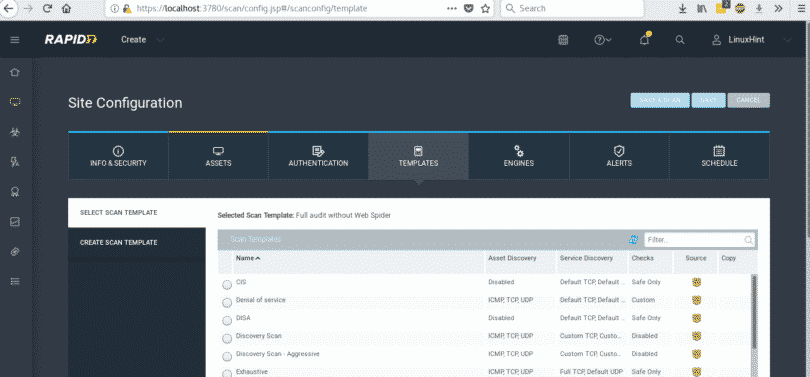


- #Ubuntu network scanner install#
- #Ubuntu network scanner update#
- #Ubuntu network scanner manual#
- #Ubuntu network scanner upgrade#
- #Ubuntu network scanner for android#
Here I first used ifconfig to see what the IP address of eth0 is and then I ping it. TX packets:52031936 errors:0 dropped:0 overruns:0 carrier:0 Ethernet interfaces Ethernet interfaces are identified by the system using predictable network interface names. This document is geared toward server administrators and will focus on managing your network on the command line. UP BROADCAST RUNNING MULTICAST MTU:1500 Metric:1 Ubuntu ships with a number of graphical utilities to configure your network devices. $ ifconfig eth0Įth0 Link encap:Ethernet HWaddr b8:ae:ed:a4:08:97 You can do the same with IPv4, but it involves an additional step to look up the broadcast address for the segment. The address ff02::1 is an anycast address targeting all hosts on the link.įinally %eth0 is the notation appended to link-local IPv6 addresses in order to indicate which interface to be using. The -c2 flag means it will send only two pings before terminating. Without that it would be slowed down by trying to perform reverse DNS on link-local addresses, which is not going to work anyway. I got the printer to be shared on the network quite easily, was wondering if there was a way to share my scanner over the network, preferably controlled over a web-browser This is because it's tiring switching the usb cable over to each laptop that needs to use it. The -n flag means no reverse DNS will be performed. Hey, I have just bought myself a new HP F2290 printer/scanner/copier. The simplest way to ping all the hosts on a LAN is with IPv6: ping6 -nc2 ff02::1%eth0
#Ubuntu network scanner manual#
Here is the ubuntu manual to use fping with different options. The network and broadcast addresses will be excluded. Specify the netmask or start/end in the targets Generate a target list from a supplied IP netmask, or a startingĪnd ending IP. Pinging a target will be made, not including the first try. This is the number of times an attempt at Nmap done: 256 IP addresses (12 hosts up) scanned in 4.46 secondsįping is another command to ping all ip in LAN.
#Ubuntu network scanner for android#
Nmap scan report for android (10.0.0.196)
#Ubuntu network scanner upgrade#
If you need more than that, there is an option for a free trial for seven days to Nessus Professional - or a full upgrade starting at USD 2,990 per year. Limited to 16 IPs with unlimited time usage. Nmap scan report for android (10.0.0.188) Nessus Essentials is Tenable's free version of its vulnerability scanner. Nmap scan report for android (10.0.0.181) Nmap scan report for android (10.0.0.148) Nmap scan report for terrance-ubuntu (10.0.0.100) You can scan other IP address ranges like 192.168.0.1 - 192.168.1.254 by typing in the following: nmap -sP 192.168.0.1/23Ī typical scan might return something like the following: nmap -sP 10.0.0.1/24 The above command will scan all IP addresses starting at 192.168.1.1 through 192.168.1.254 and show you all IPs that responded. Then you can check your entire network for all connected IP addresses by typing in the following: nmap -sP 192.168.1.1/24 Using sudo, invoke the nmap command with the -Pn argument to scan all IP addresses on your network.
#Ubuntu network scanner install#
As I said, this is a great place to start using the command line.You can install an application called nmap. Install nmap using the apt package manager. If you were to type man clamscan you'd see a list of options. You might want to run it without the -remove flag just to see what it finds first. This calls on clamscan to remove any virus it finds, show you only infected files, to act recursively by running through every subdirectory of you home directory. If you'd like to scan your home directory (all your user files), you'd type something like clamscan -remove=yes -i -r ~/ Your computer will know you're a super user because you just typed in your password a few seconds ago.
#Ubuntu network scanner update#
Now that you've installed the software, you need to update the files that it uses to identify viruses. This will tell the computer that a "super user" is telling it to install the clamav virus scanning software. In that window, type sudo apt-get install clamav. If you're feeling up to it, open a terminal window by typing Ctrl+ Alt+ t. If you're new to Linux, this is the perfect time to try out the command line interface, because it works well, and it's hard to screw anything up. You can install it from the repositories using the software center. To scan for viruses on Linux, you'd us clamav.


 0 kommentar(er)
0 kommentar(er)
